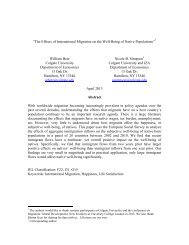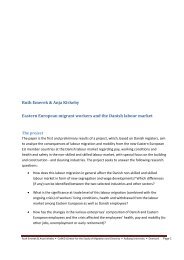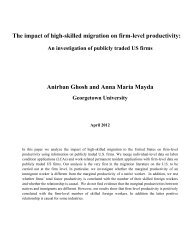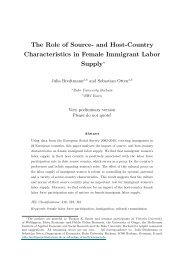La politique française de co-développement - CReAM
La politique française de co-développement - CReAM
La politique française de co-développement - CReAM
You also want an ePaper? Increase the reach of your titles
YUMPU automatically turns print PDFs into web optimized ePapers that Google loves.
are major oil exporters, five of them being both high-in<strong>co</strong>me and affluent e<strong>co</strong>nomies. Exporters of<br />
manufactured goods, like Hong Kong and Singapore, also attract foreign workers, although not in the<br />
same proportion as oil producers.<br />
In<strong>co</strong>me group<br />
4-speed world<br />
Affluent<br />
Converging<br />
Table 2 - Net immigration <strong>co</strong>untries in the South, 2010<br />
High Middle Low<br />
Bahrain (O)<br />
Brunei (O)<br />
Kuwait* (O)<br />
Macao<br />
Oman (O)<br />
Singapore* (M)<br />
Saudi Arabia* (O)<br />
UAE* (O)<br />
Argentina<br />
Venezuela (O)<br />
Botswana<br />
Costa Rica<br />
Iran (O, R)<br />
Jordan* (R)<br />
Lebanon (R)<br />
Malaysia (M)<br />
Maldives<br />
Namibia<br />
South Africa*<br />
Syria* (O, R)<br />
Thailand (M)<br />
Chad (R)<br />
Djibouti (R)<br />
Gambia<br />
Ghana*<br />
Nepal<br />
Nigeria (O)<br />
Rwanda<br />
Tanzania (R)<br />
Number of<br />
<strong>co</strong>untries<br />
Struggling Gabon (O) Côte d'Ivoire* 2<br />
Poor<br />
Comoros<br />
Kenya (R)<br />
Malawi<br />
Solomon Island<br />
Zambia (R)<br />
5<br />
Number of <strong>co</strong>untries 10 12 14 36<br />
Notes: * Top 10 net immigration <strong>co</strong>untries (in volume); (M): major manufactured goods exporters (manufactured products<br />
represent more than 50 per cent of total exports); (O): major oil exporters (oil represents more than 50% of total exports);<br />
(R): major asylum <strong>co</strong>untries (refugees represent more than 20 per cent of immigrants).<br />
Sources: The four-speed-world classification <strong>co</strong>mes from OECD (2010a); in<strong>co</strong>me groups, oil and manufactured goods<br />
exporters <strong>co</strong>rrespond to categories <strong>co</strong>ined by the UNCTAD (2010); migration and refugees data <strong>co</strong>me from World Bank<br />
(2010).<br />
8<br />
21<br />
The fact that South-South outnumbers South-North migration does not mean that going to another<br />
<strong>de</strong>veloping <strong>co</strong>untry is always the first choice of migrants from the South. In many cases, the choice is<br />
not theirs to make. Administrative barriers in <strong>de</strong>veloped <strong>co</strong>untries are so high, even for high-skilled<br />
workers, that most would-be migrants have no other option than to try their luck in other <strong>de</strong>veloping<br />
<strong>co</strong>untries. In addition, the financial <strong>co</strong>st of moving to distant richer <strong>co</strong>untries prevents most<br />
candidates from the South from doing so (Martin and Taylor, 1996). This explains why South-South<br />
migration often <strong>co</strong>rresponds to movements between poor <strong>co</strong>untries. As shown in Figure 2, while<br />
emigrants from middle and high-in<strong>co</strong>me <strong>co</strong>untries mainly move to <strong>de</strong>veloped e<strong>co</strong>nomies, migrants<br />
5







